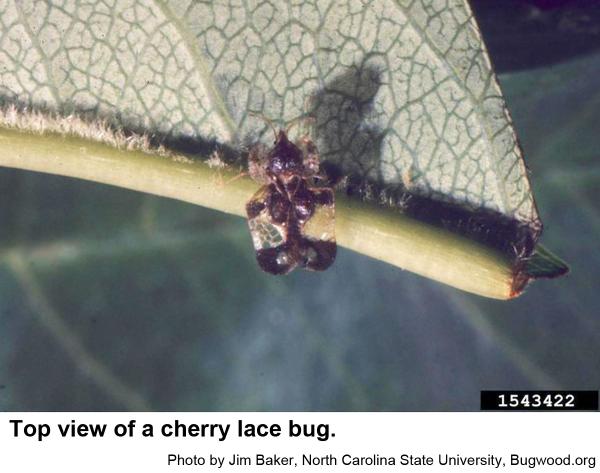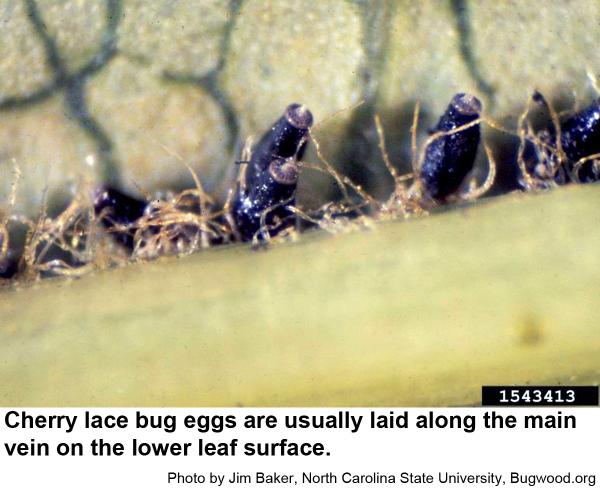Description and Biology
The cherry lace bug, Corythucha associata, is a common pest of black cherry in North Carolina. {Another very similar lace bug, Corythucha pruni, is also called the cherry lace bug. With Corythucha pruni, in side view the inflated hood that covers its head is about the same height as the hump on its back. The inflated hood that covers the head of Corythucha associata is noticably higher than the hump on its back.}. Corythucha associata is called the cherry lace bug because it feeds on wild cherry and because the thorax and wings are expanded and appear lacey. Adults are about 1/8 inch long. The side expansions of the thorax (paranota) have tiny spines on the outer edge. Each top wing has a large, C-shaped dark patch so that when the wings are folded, a dark band appears across the end and near the front of the wings (the end band has pale spots). The body is blackish and the legs and antennae are gray to tan. Females lay eggs close to the central vein on the underside of leaves. The eggs are dark brown, elongate, and taper toward each end. The top end has a circular cap with a central, pale protrusion. Cherry lace bug nymphs are small, black insects with very pale legs and antennae. They develop through five stages as they molt and grow. Older nymphs have spines around the edge of the abdomen and thorax. Like most lace bugs that infest deciduous plants, the cherry lace bug probably overwinters as adult bugs in sheltered places such as under leaves, stones, and bark. These bugs have been noticed in early May, and development takes at least seven weeks. We have at least one generation per year in North Carolina.
Host Plants
The cherry lace bug infests black cherry, Prunus serotina, (also called wild black cherry, rum cherry, or mountain black cherry) as well as Chickasaw plum, Prunus angustifolia, (also called Cherokee plum, Florida sand plum, sandhill plum, or sand plum). The tops of infested leaves soon develop pale yellow to white spots especially toward the center. Beneath, the leaf is disfigured by the bugs, their eggs, nymphs, and fecal spots.
Residential Recommendations
If the infested plant is small enough, insecticides should be applied when damage is first noticed in spring. Make sure the undersides of the leaves are covered because cherry lace bugs feed there. Alternatively, a systemic product can be applied to the soil surface under the infested plant. Imidacloprid is systemic, is labeled for residential landscape use, and is available in most big box stores, nurseries, and plant centers.
Other Resources
- Lace Bugs, Frank, S. D. and S. Bambara. 2009 (revised). Entomology Insect Notes. NC State Extension Publications.
- Some New Species of Nearctic Tingidae. Osborn, H. and C. J. Drake. 1916. Ohio Journal of Science 17: 9-15.
- The Lace Bugs (Hemiptera: Tingidae) of North Carolina and Their Hosts. Horn, K. F., C. G. Wright, and M. H. Farrier. 1979. NC Agr. Exp. Sta. Tech. Bul. 257. 22 pp.
- Extension Plant Pathology Publications and Factsheets
- Horticultural Science Publications
- North Carolina Agricultural Chemicals Manual
For assistance with a specific problem, contact your local Cooperative Extension Center
This Factsheet has not been peer reviewed.
Publication date: Nov. 17, 2018
Reviewed/Revised: Sept. 11, 2019
Recommendations for the use of agricultural chemicals are included in this publication as a convenience to the reader. The use of brand names and any mention or listing of commercial products or services in this publication does not imply endorsement by NC State University or N.C. A&T State University nor discrimination against similar products or services not mentioned. Individuals who use agricultural chemicals are responsible for ensuring that the intended use complies with current regulations and conforms to the product label. Be sure to obtain current information about usage regulations and examine a current product label before applying any chemical. For assistance, contact your local N.C. Cooperative Extension county center.
N.C. Cooperative Extension prohibits discrimination and harassment regardless of age, color, disability, family and marital status, gender identity, national origin, political beliefs, race, religion, sex (including pregnancy), sexual orientation and veteran status.






